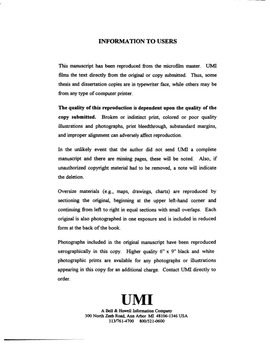| dc.contributor.advisor | Fox, Robert D., | en_US |
| dc.contributor.author | Noyes, Ronald Tacie. | en_US |
| dc.date.accessioned | 2013-08-16T12:30:21Z | |
| dc.date.available | 2013-08-16T12:30:21Z | |
| dc.date.issued | 1998 | en_US |
| dc.identifier.uri | https://hdl.handle.net/11244/5731 | |
| dc.description.abstract | Recommendations: Conduct a study of nonparticipation; incorporate new DE participation barriers and facilitators into revised engineering DE questionnaires. Use refined DF model Z234T with short questionnaire as DE participation diagnostic tool kit to screen potentially successful engineering students for NTU and other engineering DE programs. Conduct additional engineering DE research to further validate theoretical DF Z234T model and questionnaire. | en_US |
| dc.description.abstract | No studies of barriers and facilitators to participation in CPE or DE by engineers were found. A national pharmacy study questionnaire of barriers and facilitators to participation in LLL was modified for engineers, adding 30 barrier and facilitator questions. National Technological University (NTU), Ft. Collins, Colorado, which delivers M.S. degree engineering courses by satellite to U.S. corporations, was the cooperator. Three NTU participant groups were: "graduates", engineers "admitted" to M.S. programs, and engineers "taking" courses. Engineers who requested NTU information without enrolling were "non-participants." | en_US |
| dc.description.abstract | Conclusions: DF model Z234T (primary study result) accurately classified participant engineers. Barriers to participation were job/family constraints, work/family study interference, lack of desired courses and degree options, poor course advising and homework feedback. Best facilitators were: affordable learning, easy access, NTU course schedule, class during work time, flexible makeup. Qualitative research produced 20 new barriers and facilitators to participation in DE. | en_US |
| dc.description.abstract | Engineers who work for companies far from colleges face barriers to participation in continuing education such as class/work conflicts, family and social responsibilities, as well as distance, travel cost and time barriers. One-way ITV, poor advising, no instructor contact, libraries or laboratories are distance education (DE) barriers. The research purpose was to determine why some engineers participate in continuing professional education (CPE) while others do not. | en_US |
| dc.description.abstract | A panel of 20 experts recommended using two questionnaires to shorten the survey, simplify instructions and increase response rates. The survey had a 47 percent response. Regression and discriminant function analysis (DFA) were used to process quantitative data. A theoretical discriminant function (DF) model, Z234T, developed for "admitted" and "taking" groups versus "non-participants, " was 82 to 88 percent accurate. Split population samples were used to check internal and external validity. Reduction of openended question responses resulted in seven new barriers and 13 new facilitators. | en_US |
| dc.format.extent | x, 234 leaves ; | en_US |
| dc.subject | Education, Adult and Continuing. | en_US |
| dc.subject | Distance education. | en_US |
| dc.subject | Engineering, General. | en_US |
| dc.subject | Adult education. | en_US |
| dc.subject | Education, Higher. | en_US |
| dc.subject | Engineers Education (Continuing education) | en_US |
| dc.title | A study of barriers and facilitators to participation in distance higher education by working engineers. | en_US |
| dc.type | Thesis | en_US |
| dc.thesis.degree | Ph.D. | en_US |
| dc.thesis.degreeDiscipline | Department of Educational Leadership and Policy Studies | en_US |
| dc.note | Chairman: Robert D. Fox. | en_US |
| dc.note | Source: Dissertation Abstracts International, Volume: 59-11, Section: A, page: 4080. | en_US |
| ou.identifier | (UMI)AAI9911864 | en_US |
| ou.group | Jeannine Rainbolt College of Education::Department of Educational Leadership and Policy Studies | |
